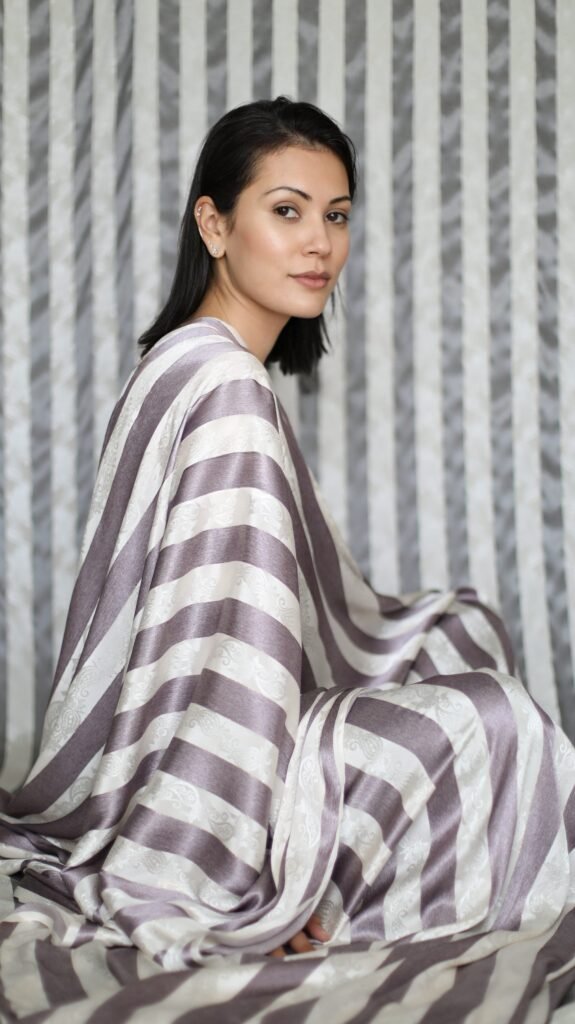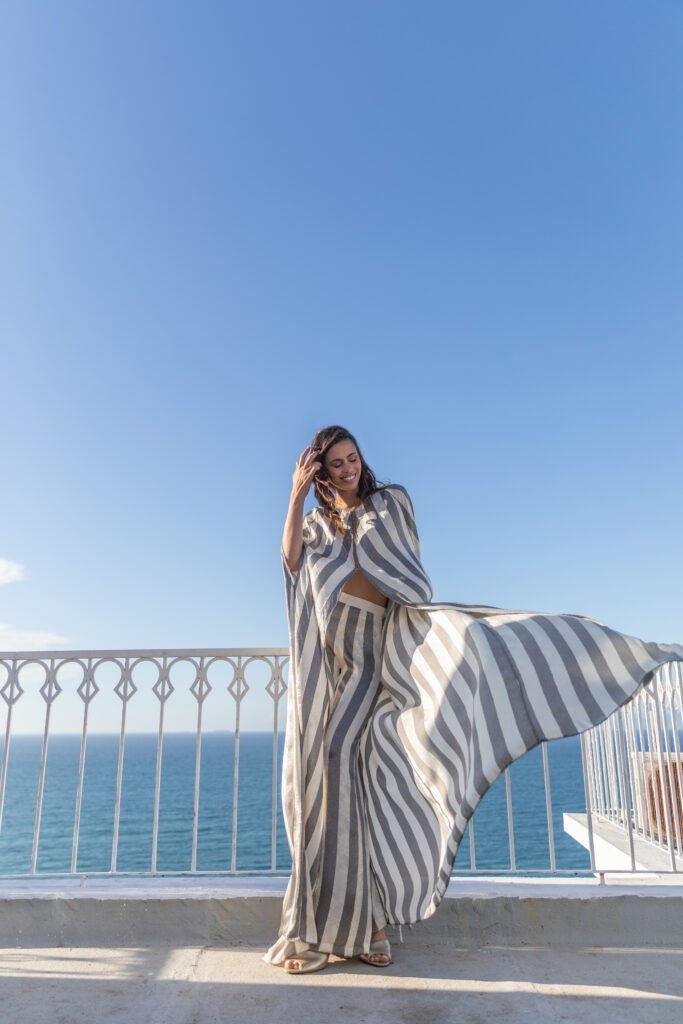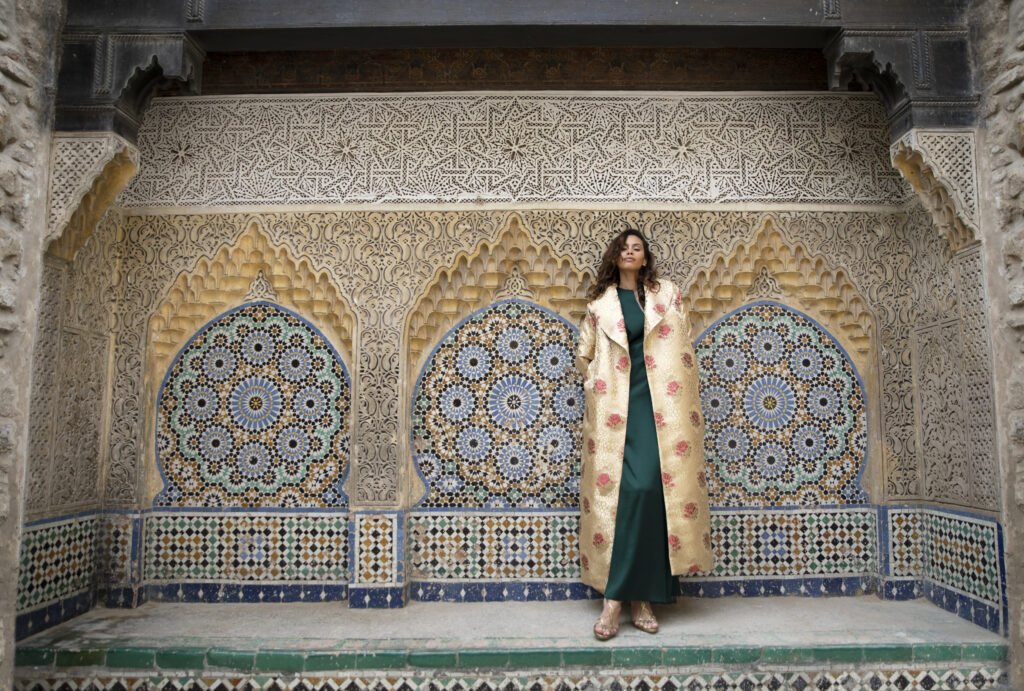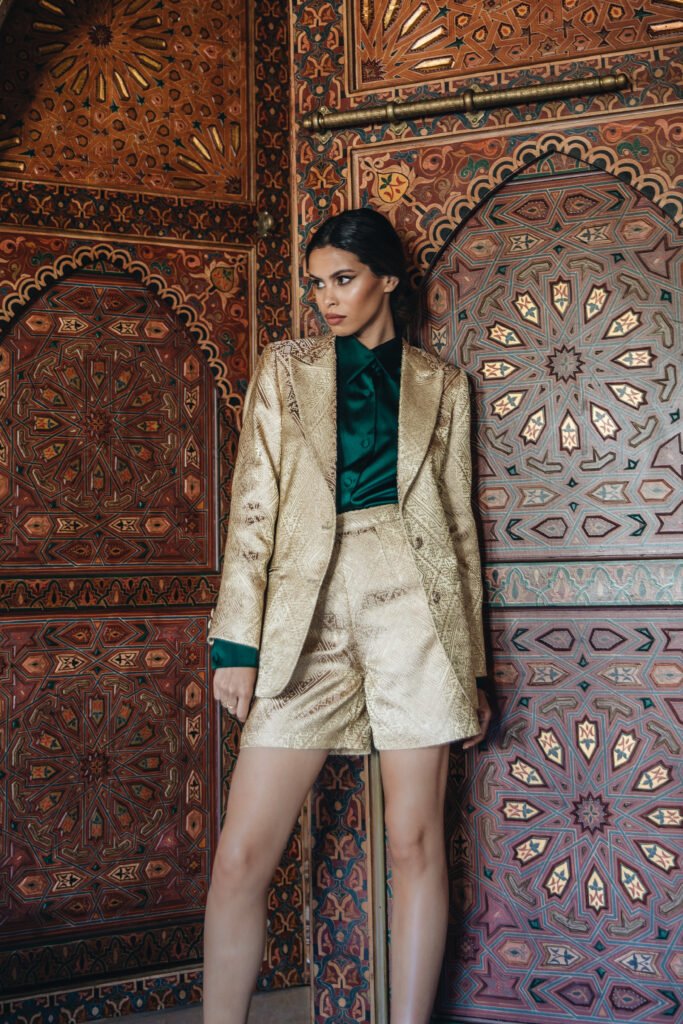Salima Chaieb - the artist and the muse.
Meredith Damouni speaks exclusively to the Moroccan designer who's taking her tradition to the world through modern design thinking and an agenda to share her beloved heritage.

Meredith Damouni speaks with Salima Chaieb, Moroccan design who’s taking traditional fabrics, adornments and motifs, adding a touch of emotion, and producing a collection that is close to home while being entirely relevant to a global community.
What gets you up in the morning?
The joy and excitement of designing for women and see them bring my cultural heritage to life. I have always been inspired by my mother's chic and glamorous style. Having grown up with this independent and creative reference, today I’m looking to dress women with timeless style, who assume their identity and remain true to themselves. No matter what fashion trends are, I want to dress women who are not afraid to dare and who are certainly rooted in their time. Everyday, I’m excited to address the challenge to put the evolution of society and history into context, reinterpret and reinvent it creatively and make it relevant for today’s women.

Tell us the story of your brand?
In 1999, I moved to Montreal, Canada with my family where I finished high school and graduated in Biomedical Sciences with a master's degree in Biomedical Engineering from Ecole Polytechnique de Montreal in 2008. After that, I worked for nearly 10 years in the medical field and then in renewable energy consulting sectors. When my passion for fashion finally took over, I decided to undergo an advanced training in fashion. For two years, while holding down my full-time job, I attended the Canadian school, Collège Lasalle in Casablanca, and graduated with a pattern-making and sewing diploma. I strengthened my knowledge by following Business Of Fashion (BOF) online courses and took two online classes: “The Art and Science of Buying and Merchandising” and “Fashion History For Today”. Once I graduated, I quit my job to officially launch our brand in 2018. Our brand’s signature is traditionally Moroccan yet modern.
Why do you stick to a line of fabrics and patterns, how do you hold yourself back?
It was very clear to me that I wanted to revisit local traditional fabrics to create modern designs. In a warm tribute to Moroccan craftsmanship, we reinterpret fabrics that were long dedicated to traditional attire, such as the jellabiya and kandora. I like to experiment with them by trying different cuts that work best with their patterns and finding the most beautiful way to showcase them. From the very beginning, the reinterpretation of fabrics made with noble materials like brocades, velvets and silks was and still is our brand’s signature. Our collections are made of ‘Lakhrib’ or the rose and the ‘El-Bahja’ or bouquet patterns woven into brocades. Also present is the ‘Terz El Gherza’, which is directly inspired by Fez geometric cross stitch embroidery found on the sheets and tablecloths included in a bride’s trousseau. We also often work with the ‘Jawhara’ which is a silk satin with jacquard stripes woven with gold or silk threads, lending notes of lightness and femininity to our collections.

Where do you see the future of the brand and why?
It’s crucial for us to keep our brand ever-evolving to meet our clients’ demands.
Through the development of our brand, what I’d really like to achieve is the ‘democratisation’ of Moroccan fashion at a global level, beyond the standard kaftans. I look to the example of Johanna Ortiz who perfectly captures the spirit of Latin America today, while also resonating with industry insiders and clients all over the world. Also, another example, Thea Porter who is credited with bringing the 70s bohemian look, through her Syrian heritage, and who helped create the iconic looks of Elizabeth Taylor.
Who would be your ultimate woman to dress?
I deeply believe in the idea that all women are muses, each one being her own or someone’s muse. Whether they are stay-at-home mothers or female entrepreneurs, women are an endless source of inspiration and imagination for me. But if I really must choose just one that embodies the spirit and values of our brand, then I would say Farida Khelfa. She's clearly an heroine of modern times, a woman with a capital W, rightfully celebrating women.
How do you define a new collection?
I first follow my instinct without thinking too much about ‘seasons’ or and ‘fashion’ agenda. To me, it’s only about emotions felt at a precise moment in that time of my life. I like the idea of designing a piece of clothing that can express the moments of joy or pain that I was experiencing. And I find it even more fascinating to imagine that this creation will go with the woman who wears it in her own moments of life. As I often create a collection starting from feelings, I like listening to songs that evoke these emotions while I’m in the creation process. I start by writing a story and then, I imagine the models and choose the fabrics that will best represent my state of mind. Designing a collection is quite emotional, questions myself and my surroundings - it’s like a kind of personal therapy.

Inspiration is everywhere and we know you’re a social media queen, how do you use social media for inspiration and the marketing of your brand?
I’m not sure about the fact that I’m a social media queen (laughs), but yes, social media is a powerful tool to showcase and promote our work and craft as a Moroccan-based atelier. I consider social media as open windows on the world through which we can share our universe. I have a particular fondness for the "story" format, it helps us show the behind-the-scenes and making-of our creations. It is also a great way to e-meet and connect with insiders of the fashion industry who will give you invaluable advice and be extremely supportive. Contrary to what one might think, I do not spend a lot of time looking for inspiration on social media. While creating a new collection, I definitely find inspiration on my personal account @epicfashionmoments (which I consider to be a continuously evolving moodboard) by bringing my personal vision of the Moroccan identity.

How important is self promotion as a designer?
Whether we have just started out or have been going for some years, self-promotion is essential at all stages of building a fashion business. As a designer, we need to dedicate time and resources to showcase our work at its best. Even if you have been designing for some years, your work needs to evolve with your clients. And potential clients like to see photographs of you at work in your atelier. Self-presentation is very important, you have to present yourself as best you can though professional photography and film. Stylish and qualitative visual materials are absolutely crucial. Having a carefully crafted design format for your online, digital and print materials, whether they be images, short films or photographs, is a must.
Tell us about your recent collaboration with Whind.
How did this come about and why was this such a valuable moment for the brands to align?
When it comes to sustainability, we’ve committed to a lighter footprint philosophy to keep what we create as low-impact as we can. Since 2018, we’ve launched the ‘Nothing Is Left, Everything Is Transformed’ (NILEIT) initiative aiming to work on our responsible commitment by reducing our environmental footprint while preserving and promoting the expertise of our local artisans. The goal is to upcycle our leftover stock and fabric scraps to create new value-added products. The first project that has been initiated under NILEIT was the Moroccan 'Boucherouite' rug weaving. Made of scrap fabric from our designs, they are rarely very large yet still display a great creativity. No two rugs are the same, ensuring a unique product. All our Boucherouites are handmade by independent female artisans living in remote villages to preserve and promote their expertise as well as our zero-waste ethos. Then, we had the opportunity to extend our initiative by teaming up with the UK-based skincare brand, Whind, to create a limited-edition, zero-waste hair scrunchie produced according to NIELT. Each scrunchie is unique and is designed using Moroccan fabrics coming from our collections. To me our sustainable initiative goes beyond upcycling; it breaths new life into leftover materials. The creative process knows no bounds.

How do you see the evolution of Moroccan brands in 2022?
I see a very bright future for Moroccan brands at an international level. There is a new generation of designers and entrepreneurs who have understood that our cultural identity is an asset we should be proud of and develop to export our heritage beyond borders.
If you could go anywhere for your summer holiday where would you go and with whom?
Since the beginning of the covid crisis, I've started thinking back in terms of slow local tourism and this summer is no exception. As I had the opportunity to shoot our latest 'Ghazali' collection in the city of Tangiers, I would definitely go back there for holidays with family and friends. This city was for centuries a crossroads for Moorish and Spanish cultures and this part of its history makes you feel that time stands still there. From strolling through the old town and visiting art galleries, the beach , Vitamin C baths, afternoon walks in Perdicaris parklands, to warm summer nights with friends enjoying festive dinners in a sea-view restaurant, you will find me this summer in the ‘dream city’ as the American author Paul Bowles named, Tangiers.
Tell us about your latest collection ‘Ghazali’?
‘Ghazali’ collection is my most personal collection to date. The difficult times I went through, the self-doubts about questioning about 'who I really was', fueled my inspiration to create this collection. The sorrows and joys that I experienced during this awakening were extremely strong feelings and designing ‘Ghazali’ became an intense therapy for me.
